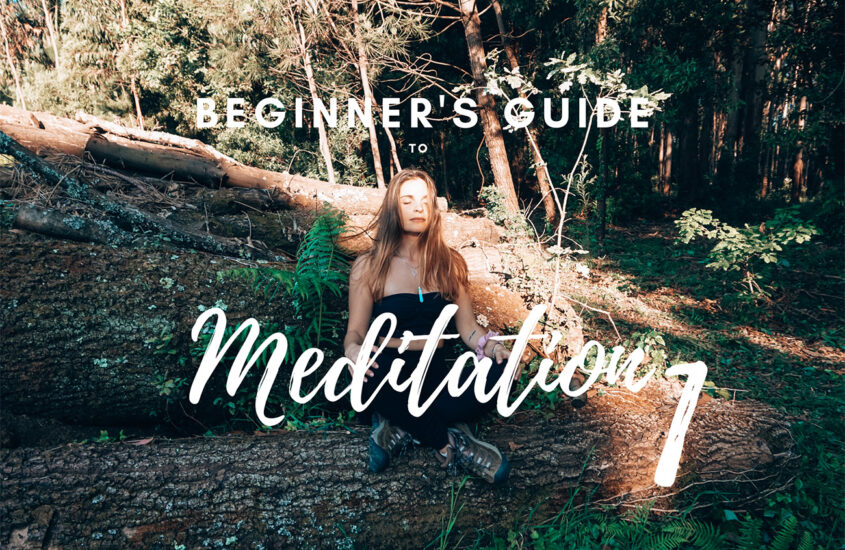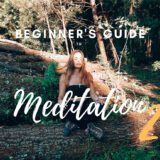Beginner’s Guide to Meditation 1: What is Meditation about?


Perhaps you are that person who has heard about meditation and who feels a certain curiosity, but who at the same time is still a little confused about what it is to meditate.
After all, what is meditation? How I can meditate? What is a meditation for? How do I know if I am meditating? How do I get rid of all my thoughts? What is so amazing about meditating? Why does it seem like everyone talks about meditating?
If this is your case, let me tell you that you have reached the right place !!! Thinking of people like you, I decided to create the “Beginner’s Guide to Meditation”, a series of articles exclusively dedicated to giving you a general understanding of meditation.
Believe me that, the simple fact that you are reading this article right now, reveals that there is a curiosity about this subject in you and that curiosity is the first step of any journey.
ABOUT MY JOURNEY
I always felt a great curiosity about meditation, however, as with most people, I sat down to meditate and could not empty my mind. After some unsuccessful attempts, I came to the conclusion that meditating was not for me, for the simple fact that not even my body could keep still, what to say about my mind.
However, in 2017 I decided to give meditation another chance and I signed up for the Vipassana retreat in Myanmar (you can read the experience here) and my whole relationship with meditation has changed. Nowadays, meditation is the greatest tool for my personal development and I am a great enthusiast on this subject because only good things came from there!
THE IMPORTANCE OF THE PURPOSE
I believe that it is essential to have a greater understanding of what this practice entails in itself, to this extent we can see which way we are going and what the purpose of sitting still.
In everything in life, I defend that we have to find our purpose in each situation, because only then can we create a strong commitment to something that keeps us going, even when we feel like giving up.
And with meditation, it is no different. However, to find a purpose in this practice I consider it is fundamental to have some acknowledge about this world and I believe that a meditation guide for beginners can help you.
My purpose or what makes me sit every day to meditate is the curiosity I have about knowing myself better and realizing that the more I know myself, the more I develop my self-love and realize how it is reflected in my reality.
Along the way, I realized other things, but my purpose is to dedicate at least 30 minutes of my day to “let’s study Maria”.
WORKOUT vs MEDITATION
I like to compare doing a workout with practicing meditation. In the same way that you go to the gym to sculpt your body and develop your muscles, you use meditation to sculpt and develop your mind.
In fact, the processes are quite similar:
- You will often be too lazy to do so;
- A minute sometimes feels like an eternity;
- The results don’t come overnight, but once they start showing up, they give you extra motivation;
- When you’re done, you’re always happy to have done it;
- If you spend a week without practicing it seems that you are two steps back on what you have already achieved;
- In general, you feel healthier, more confident, happier and more energetic;
So the more you train your body the stronger and more agile you feel, to the same extent, the more you train your mind the greater the control you have over it and the more you feel able to control what your mind focuses on and how it processes new information.
Therefore, meditation is a tool that allows you to observe the mind directly.
NOBODY TAUGHT US TO LOOK AT OURSELVES
Unfortunately, we live in a society in which, since we were children, we are encouraged to look at and analyze the external world, trying to find solutions in something external to us. This attempt to try to understand others and the world, without first knowing ourselves is one of the main reasons for so much confusion and disappointment to arise in our lives.
The truth is that very little is known about the functioning of our mind, there are several advances in neuroscience that allow us to have some knowledge about how it works, however, the part of the subconscious that is the basis of all our experiences, remains unknown and undisciplined.
Apart from meditation, there is no other method for developing control and understanding of the subconscious mind.
WHAT IS MEDITATION ABOUT?
Meditation is a precise technique for resting the mind, a state totally opposite to what we experience in our daily lives. In meditation, the mind is clear, relaxed, and focused.
When you meditate you are fully awake and alert. However, the focus is not on the external world or on what is happening around you, the focus is totally on your inner world, on what happens within you.
In this sense, you stop paying attention to the noise of the outside world and begin to observe the noise of your inner world. And as you observe without reacting and you concentrate more and more, that noise gradually tends to dissipate and you begin to enter a deep state of your Self, a deep state of concentration of the mind where you find calm and peace and then the mind is silent.
When the mind is silent and does not distract you, deep-state meditation takes place.
Meditation teaches you to see the true nature of things, by accessing a place of inner tranquility. It is a tool that you can use if you get stuck in an emotion, situation, or problem. As it helps you to get back to your center and bring you back to the present moment. It is the best tool you can have in life! And it’s free !!!
THE THINKING MIND AND THE OBSERVING MIND
Take a deep breath. Relax. And focus on each word you are reading, as you read it, become aware of your body. And focus on each word, one by one. Realize the sound that the word makes in your mind and feel your breath. Focus on the sound you are hearing right now, right now. In every word you read. Are you the voice in your mind reading this? If it is you then who is watching this happening?
This is a very simple exercise that makes you aware of your mental process, the same process that will happen to you in meditation. As you watch your thoughts come and go, you realize that there is a second “I”, or a second mind, because if you can watch it happen, it means that you are not that. There is a gap between your Self and your thoughts.
With the monks I learned that these are the two minds we have:
- The Thinking Mind
- And the Observing Mind
THE IMPORTANCE OF THE OBSERVING MIND
The Oberving Mind is a mind that does not judge, does not develop opinions about anything, it just observes. And to activate this Observing Mind, we need to focus our attention on something specific, such as breathing, body sensations, mantras, etc.
The fact that we put the focus of our attention on something in our body is for obvious reasons that we can access it easily at any time in our life, for example, the breath will be born and die with you. Do you get it?
This concept of the two minds is very important because it will give you a greater understanding of the distance between what You are (your Self) and your thoughts, feelings, and emotions.
It is from this Observing Mind that you develop during meditation, that you can use the practice of mindfulness in your daily life. Being more aware, practicing detachment (you can read more here), and creating a space of time between emotion and action, that allows you to act consciously about what is best for you at the present moment, what means, to act with presence.
THE DIFFERENT KINDS OF MEDITATION
There are several kinds of meditation and all are right, they are just different. Any practice that forces you to focus your attention on the present moment and let go of any emotion or thought is a kind of meditation. In this sense, if you are fully present in the task you are doing, you may even be washing dishes and be practicing a type of meditation.
My favorites are Mindfulness Meditation and Vipassana and I jump between them. They are my favorites because what I seek with meditation is a deep knowledge of myself and to date, these two are the ones that have brought me the most transforming results.
KINDS OF MEDITATION
- Mindfulness Meditation: Focus your attention on an object (breathing, sensations, etc .;) and whenever a thought arises, observe it without reacting or judging and turn back your attention to the object;
- Vipassana: It consists in long sequences of scanning the body in a specific order. In which we are instructed to pay attention to all the sensations that arise in this process without allowing ourselves to react to them.
- Walking Meditation: It consists of meditating while walking, placing all our attention on our feet treading the ground, one at a time;
- Zazen Meditation: It is the basis of Zen Buddhist practice and consists of sitting with your back straight and just observing the mind. To be honest, I still haven’t quite understood the difference between Zazen meditation and Mindfulness;
- Tai Chi and Yoga: They are considered types of meditation in movement, which combine breathing with body movements in full presence. I started practicing Yoga recently and I’m surrendered!
- Guided meditation: They are a modern practice that is based on different types of practice and as the name implies someone guides you through meditation. In my opinion, guided meditation is like a cane, it is very efficient because it can really calm you down and relax quickly but it always turns out to be something that entertains your mind instead of exploring it. I personally like to practice them on a more spiritual level or when I just want to calm down;
With this, I want to tell you that as you can see there are several types of meditation and that you can venture among them and see which one works best for you. Because I believe that whatever meditation you practice is certain that you will find benefits in its practice and every type of meditation will teach you something.
CONTENT INTEGRATION
With the first part of this “Beginner’s Guide to Meditation”, you have acquired the knowledge of what meditation consists of. You have realized that it is a very powerful tool to get to know you at a deeper level and how it can help you make decisions with more consciousness.
On another level you will have understood that it is natural for thoughts to arise in your head and that the only thing you have to do is to observe them, without judgment, letting them go their way. With continuous practice and a lot of patience, the interval between thoughts will be increasing, reaching mental states of deep concentration that can lead you to a deep state of calm, peace, and joy.
You have learned that you have two minds, the Thinking Mind, and the Observing Mind. And this last one is the one that is closest to your higher Self, to your essence, and that it is through meditation that you develop it.
Finally, you are left with a list of different types of meditation that you can explore and see which one makes the most sense for your journey right now.
In the next article “Beginner’s Guide to Meditation 2” we will explore several benefits that come from continuous meditation practice. And why this practice is so incredible and so many people are in love with it.
We keep together?











